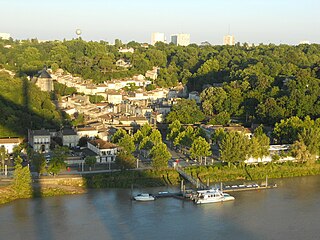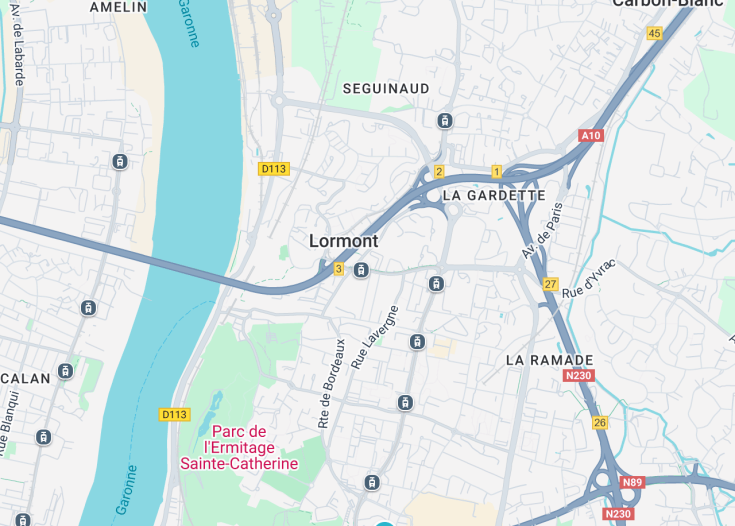Lormont, nestled along the Garonne River in the Aquitaine region of France, is celebrated for its picturesque landscapes and rich history. This charming suburb of Bordeaux features a variety of historical sites, lush parks, and scenic vineyards that attract tourists year-round. Key attractions include the 12th-century Church of Saint Martin and the Parc de l’Ermitage, offering breathtaking views of the Bordeaux skyline.
For a unique experience, take a leisurely boat ride along the Garonne River to see Lormont from a different perspective.
Ensure to visit during the late spring to early autumn months to enjoy Lormont’s outdoor activities in pleasant weather conditions.
Top things to do & see in Lormont
Select the following sights and activities to discover best tickets and tours available in Lormont.
Lormont: Gateway to Bordeaux
| Country | France |
| Time in Lormont | GMT+1 |
| Language spoken | French |
| Population | 22,000 (Source: INSEE 2021) |
| Currency | Euro (€, EUR) |
| Airports |
|
Lormont, located in southwestern France and part of the Bordeaux metropolitan area, carries a profound historical legacy enhanced by its strategic position along the Garonne River. This small town is rich with cultural heritage, exemplified by its ancient church of Saint Martin and the recently restored Château des Lauriers. Lormont serves as a vital suburb of Bordeaux, offering scenic river views and verdant landscapes that contribute to the region’s famed wine and Bordeaux’s urban life.
Historically, Lormont was recognized as a crucial defensive site and religious center since the early Middle Ages. It became a favored residence of the Black Prince, Edward of Woodstock, during the 14th century due to its significant location and has since played a consistent role in regional trade and transportation. Today, Lormont attracts visitors with its picturesque setting and proximity to Bordeaux’s dynamic city center, making it a peaceful yet connected destination. The area’s compelling blend of history, culture, and modern amenities makes it a unique spot within the larger Bordeaux region.
Lormont’s redevelopment efforts, particularly around the waterfront area, reflect its adaptation to contemporary urban challenges while preserving its rich historical tapestry. It remains a tranquil yet vibrant community, embodying the essence of French charm right at the doorstep of one of the country’s most bustling urban centers.
Where is Lormont?
Lormont is situated northeast of Bordeaux, along the banks of the Garonne River in southwestern France.
Distances:
| Route | Distance by car | Time by car |
|---|---|---|
| Bordeaux to Lormont | 8 miles (13 km) | 20 minutes |
| Paris to Lormont | 352 miles (566 km) | 5 hours 30 minutes |
What is Lormont famous for?
Lormont is renowned for its historical sites like the Church of Saint Martin and panoramic views over the Garonne River, making it an attractive municipality within Bordeaux’s metropolitan vibe.
History
Prehistoric to Medieval Times (Before 500 AD – 1400s)
The area now known as Lormont has been inhabited since prehistoric times, as evidenced by archaeological findings such as flint tools and pottery. The strategic location along the Garonne River made it an appealing settlement for various cultures, including the Romans, who likely established initial paths and fortifications. During the Middle Ages, Lormont grew in prominence due to its position on major pilgrimage routes and its proximity to Bordeaux. The construction of the Church of St Martin is a notable medieval landmark dating from this period.
Early Modern Period (1500s – 1700s)
In this era, Lormont underwent considerable development. The town became a favorite spot for Bordeaux’s wealthy citizens to build elegant manors and chateaux, few of which survive to this day. It was during the 16th century that Lormont was briefly held by the English during the conflicts associated with the French Wars of Religion, which briefly interrupted its development.
Industrialization to Modern Day (1800s – Present)
The 19th century marked a pivotal point in Lormont’s history with the onset of industrialization, including shipbuilding and various manufacturing industries that took advantage of the Garonne River for transportation. However, the latter half of the 20th century saw a decline in these industries, leading to economic shifts and restructuring. In recent years, Lormont has transformed into a residential suburb of Bordeaux with a focus on improving its public infrastructure and quality of life, preserving its rich history while adapting to modern needs.
Visit Lormont
What to see and do in Lormont
The picturesque town of Lormont, located on the right bank of the Garonne River, offers visitors a unique mixture of historical sites and natural beauty. Noteworthy attractions include the Church of St Martin, a beautiful example of Gothic architecture with a rich history. The Parc de l’Ermitage Sainte-Catherine provides stunning vistas of the Garonne and Bordeaux, ideal for leisurely walks or picnics. Nature enthusiasts will appreciate the preserved green spaces like the Parc des Iris.
- Explore the historic Château des Lauriers.
- Walk the scenic path along the riverfront.
- Visit local vineyards to taste regional wines.
Festive Lormont
Lormont hosts a variety of cultural and traditional events throughout the year, enriching the community spirit. The annual ‘Festival des Hauts de Garonne’ is a must-see, featuring world music performers every July. Another significant event is the ‘Lormont Christmas Market’ in December, offering a charming festive experience with crafts, local delicacies, and activities.
Best time to visit Lormont
The ideal time to visit Lormont is from late spring to early autumn, specifically May through September, when the weather is most favorable. This period provides the perfect conditions for exploring the outdoors and participating in local events.
Is Lormont worth visiting?
Lormont, with its rich tapestry of history, culture, and natural beauty, is certainly worth a visit. The blend of historical architectures like the Church of St Martin, alongside the natural landscapes of the Garonne riverside, offers a unique travel experience. While it might not boast the bustling nightlife of larger cities, its peaceful environment and proximity to Bordeaux make it an appealing choice for those looking for a blend of tranquility and historical exploration. However, visitors looking for extensive entertainment options might find it less appealing.









